January 17, 2023
Dravidastan, Dravidanadu, Tamilnadu – How ideology, racism and polity change and work from the 19th century to the 21st century! (1)
The ideological fight between the Governor and the CM: A day after Governor RN Ravi’s “Tamilagam” remarks, former union minister TR Baalu came down heavily on him, saying[1], “He (Ravi) is using Raj Bhavan to make those remarks that have to be made from Kamalalayam (BJP headquarters).” Ravi had said “Tamilagam” would be a more appropriate word to address the state of Tamil Nadu[2]. In a press statement, the former union minister said, “The Governor has been frequently dwelling upon topics like Sanatana, Aryan and Dravidian concepts, besides talking about Tirukkural and colonialism which are dangerous and absurd.” The Dravida Munnetra Kazhagam (DMK)-led Tamil Nadu government and state Governor RN Ravi have been at loggerheads over several issues[3]. Most recently, the DMK has taken strong exception to Ravi’s recent remarks allegedly terming Dravidian politics as ‘regressive politics’[4]. The Governor also suggested changing the name of the state to ‘Tamizhagam’. How has the MK Stalin-led DMK responded to this, and what is the history of the disagreements between the Tamil Nadu state government and the Governor are debated in the media, political platforms and halls.
Annadurai’s Dravidian stock and Stalin’s Dravidian model: The Dravidian fight has already started, the moment Stalin declared that he belonged to a “Dravidian stock,” specifically mentioning such expression. Annadurai presented his thesis in a style that conveyed the historical importance of the occasion. It was his maiden speech in Parliament (1962) and he said: “I claim Sir to come from a country, a part of India now, but which I think is of a different stock, not necessarily antagonistic. I belong to the Dravidian stock. I am proud to call myself a Dravidian. That does not mean I am against a Bengali or a Maharashtrian or a Gujarati. As Robert Burns said, ‘A man is a man for all that.’ I say I belong to the Dravidian stock only because I consider that Dravidians have got something concrete, something distinct, something different to offer to the nation. Therefore, it is that we want self-determination.” A chief minister may be called Stalin. He may have a Nehru and a Gandhi in his cabinet, but, they are all of proud Dravidian stock. The racial claim with the often “Manila suyatchi” (State autonomy) call and other glitches have the separatist attitude. Therefore, such racial, racist and racialist verbose put them “anti-national” category. In spite of such well-known issues, the Dravidian ideologists continue to create problems.
The mythical Aryans and Dravidians[5]: The ethnic interpretation and connotation of Caldwell’s linguistic ‘Dravidian’ has led to the racial hypotheses and theories of ‘Dravidians’. Though the concepts of race and language are two separate entities, the “Dravidians’ are still held only in the racial esteem against the so called “Aryans”, in all religious, social and political interactions and processes, even today. Indeed, Bishop Robert Caldwell (1814-1891) himself has shown the way for such a transition to take place from linguism to racism, in the case of ‘Aryans’, it was the study of Sanskrit literature, particularly, the Vedas that played a crucial role in their invention, whereas, comparative linguistic study, but not the study of ancient Tamil literature, popularly known as ‘Sangam literature’, which has resulted in the production of “Dravidians’. When ‘Aryans’ could be found only in the Sanskrit literature, but also in the ancient Tamil literature, ‘Dravidians’ are not at all found in the ancient Tamil literature, but in the Sanskrit literature mostly in the geographical context. Thus, the DMK has revived such antagonism with their expressions, Dravidian stock, Dravidian model, “Ondiyam” (Union) instead of “Mathiya arasu” (Central Government) and so on.
DMK grows with casteist ideology: When ‘Dravidian’ was employed by Robert Caldwell in his 1856 book, Comparative Grammar of the Dravidian or South Indian Family of Languages, he was, he said, drawing from Kumarila Bhatta’s usage of the word. But unlike Bhatta and the others, Caldwell used ‘Dravidian’ as a generic name for the family of languages spoken in southern India to distinguish them from Indo-Aryan, the branch of Indo-European languages spoken in the Indian subcontinent[6]. Credit must also be accorded to Francis Whyte Ellis (1777-1819), a British administrator who was the first to point out that the South Indian languages were a distinct family. Stalin’s assertion of his Dravidian identity harks back to both these proud histories[7]. Tamil identity embodied in the ancient Tamil language as well as the DMK’s origins in a social justice movement that eschews caste and religion both find a place in the moniker ‘Dravidian’. But, it has been growing only with casteist politics winning elections.
Tamil Nadu vs Tamilagam – Pongal greetings: Amid growing tensions between Governor RN Ravi and the DMK-led government, a Pongal invitation from the Raj Bhavan has sparked a fresh controversy as it mentions Ravi as Tamilagam Governor[8]. It is to be noted that he was mentioned as Tamil Nadu Governor in the invitation in the previous years. MP Su Venkatesan took to his official Twitter handle and wrote[9], “Governor invitation. Last time, the invitation letter had the Tamil Nadu government’s motto. This time the invitation has only the Indian government’s motto in three places. He refused to use it because Tamil Nadu is written in our motto. Similarly, can we expect him to walk away from the tax money and rented house of the people of Tamil Nadu?.” (sic). Of course, none takes his speech seriously, as he makes such verbose very often in every context. Earlier on Monday 09-01-2023, the maiden Assembly session of 2023 began with the customary Governor’s address in which Ravi skipped portions of the government-prepared customary address in the Assembly. It is to be noted that the Governor ‘omitted’ two paragraphs highlighting the Dravidian model of governance and lauding the contributions of Dravidian leaders Periyar, Anna, Kalaignar, and Kamarajar. As it was his speech and he could not do that. Definitely, he has the right to change his view based on facts and figures.
Tamil Nadu vs ‘Tamizhagam’: What Governor RN Ravi said: While addressing a program felicitating organisers and volunteers of the Kashi Tamil Sangamam, held at the Raj Bhavan in Chennai on January 4, 2023, Ravi allegedly remarked that the word ‘Tamizhagam’ was a more appropriate term for Tamil Nadu. “Here in Tamil Nadu, a different kind of narrative has been created. Everything applicable for the whole of the country, Tamil Nadu will say no. It has become a habit. So many theses have been written – all false and poor fiction. This must be broken. Truth must prevail,” he said, PTI reported. “Thamizhagam would be a more appropriate word to call it,” he said. The word ‘Nadu’ in the Tamil language means ‘land’, but has come to mean ‘country’ at times, viewed through the lens of Tamil nationalism. Ravi seems to have suggested the word ‘Thamizhagam’ instead to distance from the interpretation of the term ‘Tamil Nadu’ as more of an autonomous region, than one that is part of India.
Regressive politics followed with separatism by the Dravidian protagonists: According to a press release by Raj Bhavan, he also said, “There has been regressive politics with the wrong habit of refusing everything that benefits all sections of people including academicians blindly for their own interests, claiming that the state is not integrally part of India,” the release said. The Governor reportedly said that for over 50 years, efforts had been made to reinforce the narrative that Tamil Nadu is not an integral part of India. “Tamil Nadu is soul, an idea and an identity of Nation and we should keep it alive to erase some falsehood and fiction of negative approach prevailing in the state,” he said.
Tamil Nadu or Thamizhagam?: A political clash between Tamil Nadu Governor RN Ravi and the MK Stalin government in the state has revived a debate over the name “Tamil Nadu” and its significance in Dravidian politics[10]. The ruling DMK accuses the Governor of making dangerous statements only to push the agenda of the state’s opposition BJP and its mentor Rashtriya Swayamsevak Sangh (RSS). On the other hand, Mr Ravi claims the ruling party and its allies symbolise Tamil chauvinism in politics, and he is seen to be at odds with Dravidian ideology[11].
- The word “Nadu” in Tamil Nadu could mean “nation”. So, Tamil Nadu means “a nation of Tamils” while Thamizhagam means the “home of the Tamil people”.
- Governor Ravi reportedly suggested Thamizhagam as a “more appropriate” name for Tamil Nadu. According to him, efforts were made over the years to push the narrative that Tamil Nadu is not an integral part of India.
- His argument is that because of the meaning of “Nadu”, the word could be seen to depict an autonomous region that is part of India.
- The DMK disagrees. “The name Tamil Nadu indicates our language, tradition, politics and life itself. This land will remain Tamil Nadu forever,” said DMK MP Kanimozhi.
- The DMK’s mouthpiece “Murasoli” was scathing on the Governor – “He says the name Tamil Nadu indicates a sovereign nation. Does the name Rajasthan sound like Pakistan, Afghanistan, Uzbekistan, or Turkmenistan to you? Isn’t Maharashtra a secessionist name for its name indicates the land of Marathas? Kerala’s tourism slogan, ‘God’s own country’, may also be a demand for a nation-state status. Isn’t it problematic for you to find a ‘Desam (land)’ in Telugu Desam Party?”
- The name “Thamizhagam” was first used by Periyar EV Ramasamy in 1938. But he also favoured Tamil Nadu as an option for renaming Madras.
- Though initially, the DMK had demanded a separate nation, it gave up the demand after the then Madras state was renamed Tamil Nadu.
- “After it was renamed Tamil Nadu, we said we are with you and wanted more powers. Now that’s closed,” said DMK spokesperson and former MP TKS Elangovan.
© Vedaprakash
17-01-2023
[1] Indian Express, Guv RN Ravi’s ‘Tamilagam’ remark fuels another row, Published: 06th January 2023 05:50 AM | Last Updated: 06th January 2023 05:50 AM.
[2] https://www.newindianexpress.com/states/tamil-nadu/2023/jan/06/guvs-tamilagam-remark-fuels-another-row-2535123.html
[3] Indian Expess, Tamil Nadu vs ‘Tamizhagam’: Why Governor RN Ravi’s latest remarks have sparked a row with DMK, Written by Varsha Sriram, Edited by Explained Desk, New Delhi | First published on: 09-01-2023 at 09:18 IST, Updated: January 10, 2023 14:16 IST.
[4] https://indianexpress.com/article/explained/explained-politics/tamil-nadu-vs-tamilagam-governor-rn-ravi-row-dmk-8368892/
[5] K. V. Ramakrishna Rao, The Dravidian Problem, The paper “Dravidians – A Literary & Anthropological Study” was presented at 52nd session of Indian History Congress, held at New Delhi from February 21-23, 1992.
Modified version under the title “Dravidian Problem” was presented at BISS National Conference, Warangal from December 26-27, 1992.
Published in the proceedings of the BISS, Warangal, India, 1992, pp.38-45. Full paper can be accessed and downloaded from here:
https://archive.org/details/TheDravidianProblemKVRRao/mode/2up
[6] Deccan Herald, A look at the linguistic and socio-political history of ‘Dravidian stock’, Karthik Venkatesh, MAY 13 2021, 00:55 ISTUPDATED: MAY 13 2021, 04:50 IST
[7] https://www.deccanherald.com/opinion/in-perspective/a-look-at-the-linguistic-and-socio-political-history-of-dravidian-stock-985292.html
[8] DtNext, Pongal invite from ‘Tamilagam’ Guv Ravi sparks row, Online Desk, Updated on: 10 Jan, 2023, 12:01 pm
[9] https://www.dtnext.in/tamilnadu/2023/01/10/pongal-invite-from-tamilagam-guv-ravi-sparks-row
[10] NDTV, What Is The Tamil Nadu vs Thamizhagam Row? Explained In 8 Points, India, News Reported by J Sam Daniel StalinUpdated: January 10, 2023 9:37 pm IST.
[11] https://www.ndtv.com/india-news/what-is-the-tamil-nadu-vs-thamizhagam-row-explained-in-8-points-3680729
Tags:annadurai, anti-brahmin, ariya, ariyan, ariyar, arya, aryan, aryan blood, aryan race, atheism, atheist, atheist rulers, brahmin, C.N.Annadurai, city, country, district, dravid, Dravida kazhagam, dravidar, dravidian, dravidian atheism, Dravidian atheists, dravidian language, dravidian model, dravidian stock, EVR, jeyalalita, kanimozhi, karunanidhi, M.K. Stalin, MGR, nation, parppanan, Periyar, Periyar Dravida Kazhagam, place, race, racialism, racialist, racism, racist, racist dravidianism, radical, radical dravinianism, radicalism, self-rule, separatism, separatist, state, state autonomy, tamil, Tamil chauvinism, tamil chauvnism, tamil separatism, tamilachi, tamilnadu, Tamilnadu government, union
Posted in ambedkar, annadurai, anti-brahmin, anti-Hindu, anti-Hindu atheism, Anti-Hindu Government, anti-vedic, arya, aryan, aryan race, atheism, atheist, atheist interference, BJP, blasphemous speech, blasphemy, brahmin, british raj, C. N. Annadurai, Caldwell, casteism, chronology, classical, communal, communalism, communists, Congress, constitution, conversion, corruption, cow, cow slaughter, CPI, CPIM, dalit, dalitastan, depressed caste, depressed class, derogatory speech, devadasi, discrimination, disparage, disparaging speech, DK, DMK, Dravida Nadu, Dravidanadu, dravidastan, dravidian, dravidian atheism, Dravidian atheists, Dravidian civilization, dravidian model, dravidian race, dravidian stock, E. V. Ramaswami Naicker, economy, election, equity, EVR, gender, gender equality, hate speech, hate-speech, hindutvavadi, Hindutwa, hintutva, historicity, historiography, history, Hitler, idol, idolatory, Indian history, Indus, indus script, intercourse, jeyalalita, K. V. Ramakrishna Rao, K.V.Ramakrishna Rao, kanimozhi, Karunanidhi, language, Marxism, Marxist historian, Marxist historiography, marxist interpretation, NDA, Periyar, Periyar Dravida Kazhagam, race, racialism, racism, radicalism, rationalist atheism, saffron agenda, saffron brigade, saffron goons, secular, Secular Front, secularism, social justice, Social welfare, spirit, spiritual, spiritualism, spirituality, stalin, tamil, Tamil chauvinism, tamil chavunism, tamil language, tamil literature, Tamil Nadu, tamil racism, tamil separatism, tamilazgagam, tamilnadu, Tamilnadu government, vandalism | Leave a Comment »
January 20, 2018
Vairamuthu’s research on Andal, the “quoted quote research methodology,” and the confession of “eminent historians”!
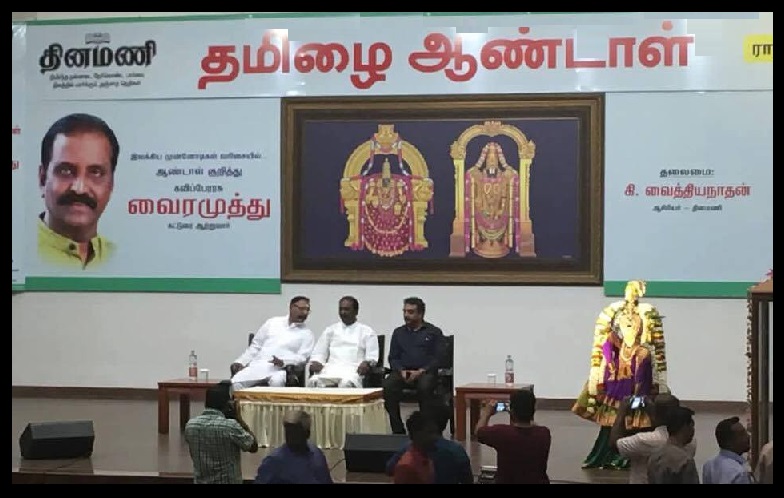
The controversy started with Vairamuthu on Andal (07-1-2018): What Vairamuthu wrote about Andal as appeared in “Dinamani” in Tamil, and its translation is given as follows[1]: “As Andal was not born to Periyazhwar, there were no details available about her birth, though, she was brought up by a Brahmin, as the society that was controlled with caste stratification might not accept her into such caste hierarchy, Andal herself had already attained the freedom of word with force and there was a practice of offering women to temple accepted by the then society, some researchers have been compelled to arrive at stunning conclusions. The book ‘Indian Movement: some aspects of dissent, protest and reform’ edited by Subash Chandra Malik of Indiana University, USA contains such reference as follows: Andal was herself a devadasi who lived and died in the Srirangam Temple. The devotees might not accept this, but, those who oppose patriarchy and socio-religious (code) might think about it.” This created the controversy that is still raging in Tamilnadu and some parts of Andhra and Karnataka. Ironically, now, Dinamani has removed the controversial or rather blasphemous article and their regrets are appearing there[2].
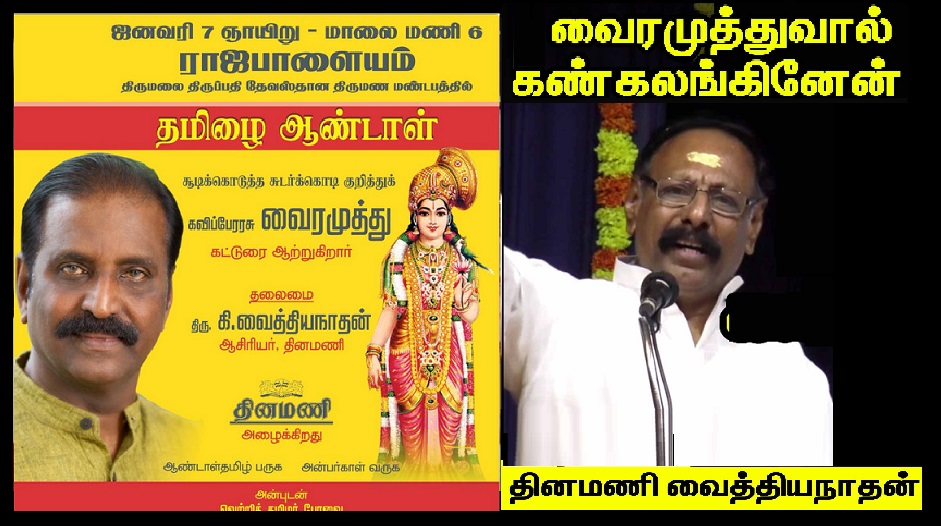
Verification of the book referred to by Vairamuthu: Now, let us analyze the “quote” of the learned poet and writer of Vairamuthu. As he has given the reference, now, as a “researcher”, anyone can go to the source and verify.

Thus, let us see the book under reference. M. G. S. Narayanan and Veluthat Kesavan published a paper, “The Bhakti Movement in South India” in “Indian Movements: Some Aspects of Dissent Protest and Reform,” edited and introduced by S. C. Malik and published by Indian Institute of Advanced Study, Shimla in 1978. In which, what they claimed was,
“Cheraman Perumal Nayanar notes the reception given to Shiva by devadasis of all ages while he went out in procession around the streets in Kailas35, and Andal herself is a Devadasi who lived and died in the Sri Rangam Temple36.”
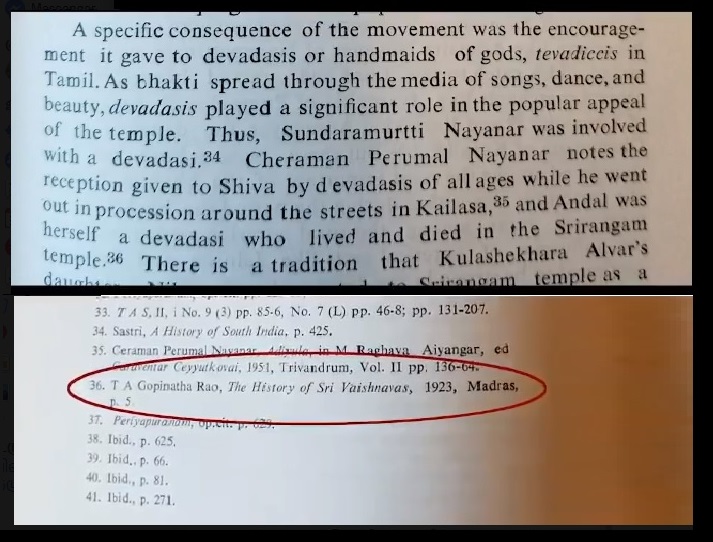
The two footnotes given for support for those two lines are as follows:
- Ceraman Perumal Nayanar, Adiyula, M. Raghava Aiyangar, ed. Caruventar Ceyyukovai, 1951, Trivandrum, Vol.II, pp.136-64.
- T. A. Gopinatha Rao, The History of Sri Vaishnavas, Madras, 1923, Madras, p. 5.
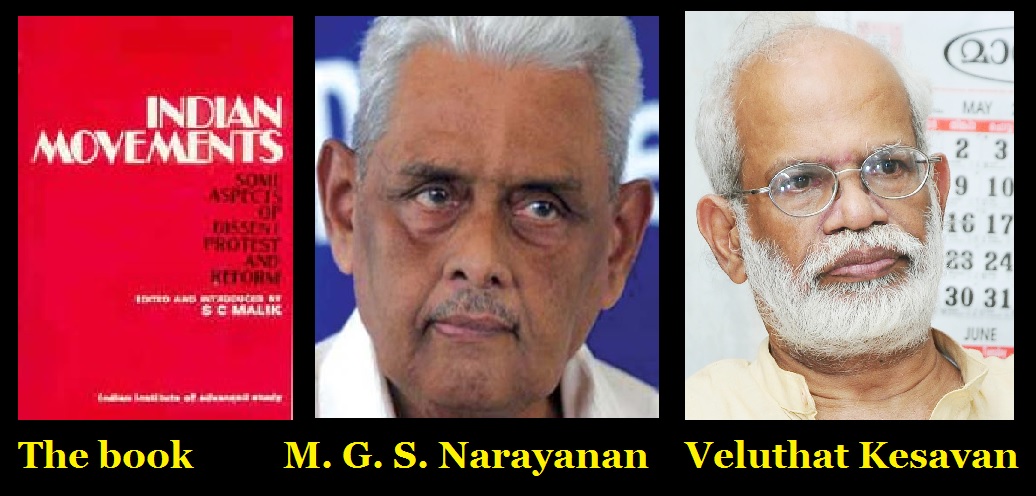
So when we look at page no.5 of the said book, what, T. A. Gopinatha Rao recorded is this, “When she reached marriageable age, she refused to marry anyone except the God Ranganatha of the Srirangam temple. The God appeared to the Alvar in a dream to declare before him his acceptance of the girl in marriage and ordered her to be brought to his residence at Srirangam. Periyalvar took her there with great eclat and left her in her Lord’s house and returned to his quiet residence at Srivilliputtur.”
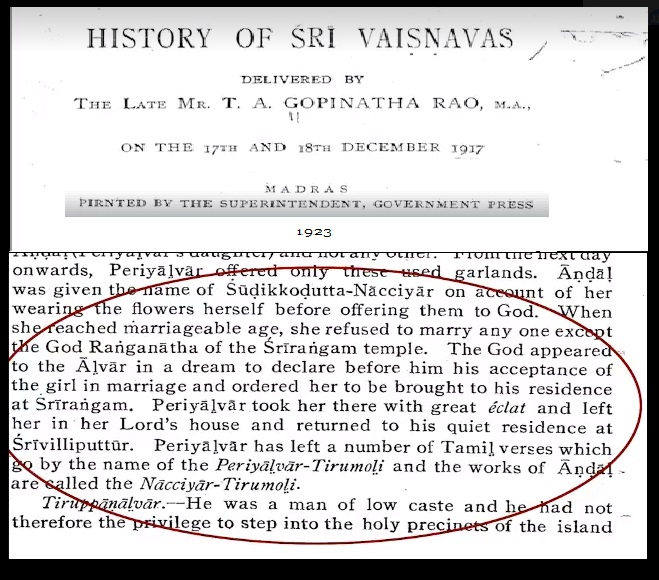
Therefore, there is nothing like what the learned historians M. G. S. Narayanan and Veluthat Kesavan reportedly claimed, “Andal herself is a Devadasi who lived and died in the Sri Rangam Temple.” Why then, the leaned “historians” wrote in that way and what was their motive?
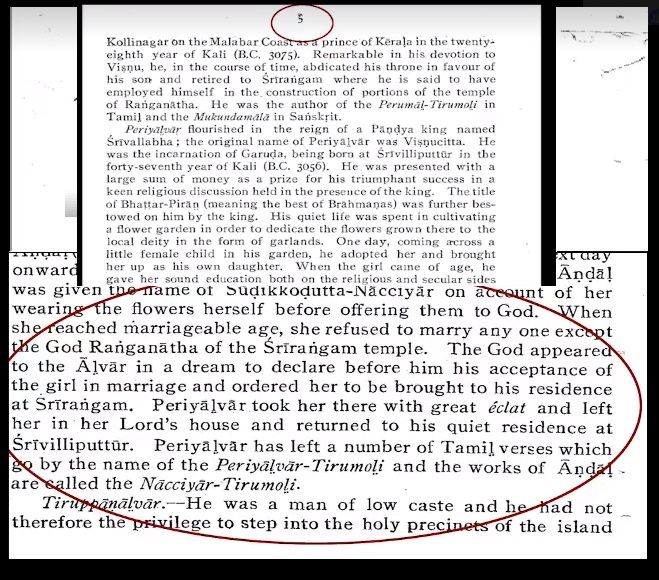
M. G. S. Narayanan clarified to Dinathanthi that there was no such reference to Devadasi[3]: When Asoka Vardhini contacted M. G. S. Narayanan through phone, he accepted that there was no specific reference to Andal as devadasi and he mentioned it based on inference only. He also accepted that Veluthat Kesavan was a student of him, doing M.A history (implying that he might not have been having research expertise at that time). There is no inscriptional evidence to that effect and it was written only based on “oral tradition.” When she asked specifically, he specifically confessed that there is no primary evidence and even secondary evidence to that effect, it was a controversial interpretation and a “matter of inference”. Then, naturally, it is intriguing and shocking to know as to know how they could have written conclusively, “Andal was herself a devadasi who lived and died in the Srirangam Temple.” Now, he is considered as one of reputed and eminent historians of India, former chairman of ICHR and so on. Why them, they stooped to such “quoted quote” research methodology, amounting faking and forging such lies and falsehood in historiography?
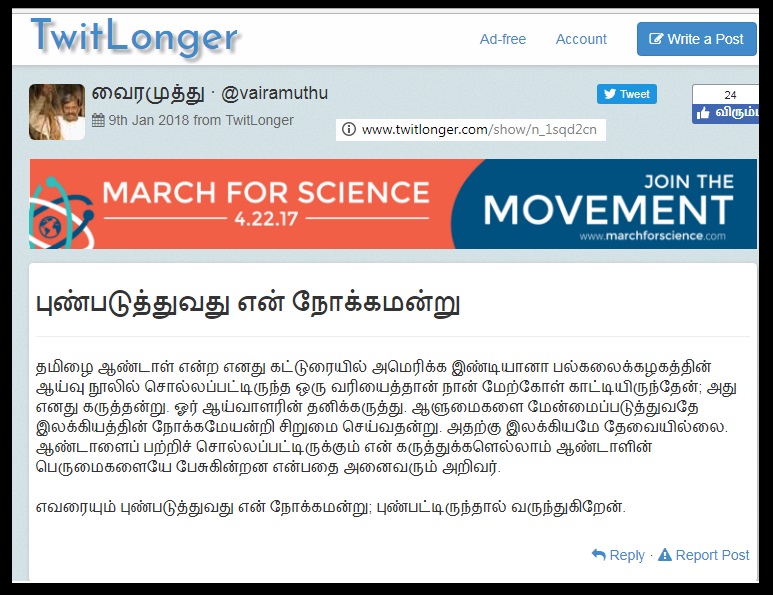
The implications of “quoted quote research,” bogey of “eminent historians” and other modern-day mythistories: Now let us analyze their quotations, reportedly lifted from two books mentioned above.
- The book in question was published by Indian Institute of Advanced Study, Shimla in 1978 and not by Indiana University, USA as claimed by Vairamuthu.
- Vairamuthu should have verified the sources before quoting, that too, part of a sentence picking up from their paper. He must have consulted the original sources (as he knows Tamil very well) and also other secondary sources after 1978 to present his speech and “researched” article appeared.
- Ironically, he and the press, still carry such wrong and falsified blabbering[4]. “As part of my research for writing this article on Aandaal, I happened to read a collection of articles edited by Subhash Chandra Malik in the name of “Indian Movements: Some Aspects of Dissent, Protest and Reform”, the original from Indiana University and published by Indian Institute of Advanced Study in 1978. It is very much an Indian research study by Indian historians,”thus claimed Vairamuthu.[5]
- Vairamuthu added, “Professor M.G.S Narayanan & Professor Kesavan Veiuthat. Professor M. G. S Narayanan is considered as “one of India’s top authorities on ancient history” and has served as the chairman of Indian Council of Historical Research. Professor Kesavan Veluthat is the Professor of History in University of Delhi. The line mentioned in my article was from a reputed publication and by reputed historians.” But, M. G. S. Narayanan now refuted. Here, Vairamuthu mentioned, “G.S Narayanan is considered as “one of India’s top authorities on ancient history,” whereas, the subject dealt with has not been so ancient!
- “Cheraman Perumal Nayanar notes the reception given to Shiva by devadasis of all ages while he went out in procession around the streets in Kailas35.” M. G. S. Narayanan himself accepted that the story of Cheraman Perumal was a myth floated after 13th century by the vested Mohammedan groups. Therefore, the question of devadasis of all sorts going out in procession is redundant, immaterial and incompetent.
- “Andal herself is a Devadasi who lived and died in the Sri Rangam Temple36.” This is also fake, fraudulent and deceptive, as T.A. Gopinatha Rao never mentioned such sentence in his book, as pointed out above.
- It is unbecoming for these researchers, now, paraded as “historians” to quote that was not there in a book, secondary source.
- It exposes the dubious and dangerous nature of “quoted quote” research methodology, as most of the researchers, may not look into the quotes recorded by the “eminent historians.”
- Coming to ideology, it is evident that the involved personalities have been Marxists and atheists and thus, their speeches and writings have been tarnished with bias, prejudice and without objectivity.
- As the Marxist ideology is coupled with Dravidian ideology of atheism, that is directed against Hindu religion, evidently, Hindus have come to streets. How they have been oppressed, suppressed and attacked by them since 1960s have been too well-known to be repeated here.
© Vedaprakash
19-01-2018.
[1] “ஆண்டாள் பெரியாழ்வார்க்குப் பிறந்த பெண் இல்லை ஆதலாலும், அவள் பிறப்பு குறித்த ஏதும் பெறப்படாததாலும், ஓர் அந்தணரே வளர்த்திருந்தாலும், குலமறியாத ஒருத்தியைக் குலமகளாய்க் கொள்ள சாதிக் கட்டுமானமுள்ள சமூகம் தயங்கியிருக்கலாம் என்பதனாலும், சமூகம் வழங்காத பாலியல் சொல் விடுதலையை ஆண்டாளே ஆவேசமாய் அடைந்துவிட்டதாலும், கோயிலுக்குப் பெண்ணைக் காணிக்கையாக்குவதை அரசும் சமூகமும் அங்கீகரித்ததாலும் கலாசார அதிர்ச்சி தரத்தக்க முடிவுக்குச் சில ஆய்வாளர்கள் ஆட்படுகிறார்கள். அமெரிக்காவின் இண்டியானா பல்கலைக்கழகம் சுபாஷ் சந்திர மாலிக்கை ஆசிரியராகக் கொண்டு வெளியிட்ட Indian Movement: some aspects of dissent, protest and reform என்ற நூலில் ஆண்டாள் குறித்து இப்படி ஒரு குறிப்பு எழுதப்பட்டிருக்கிறது Andal was herself a devadasi who lived and died in the Srirangam Temple. பக்தர்கள் இதை ஏற்றுக்கொள்ள மாடார்கள். ஆனால் ஆணாதிக்க எதிர்ப்பாளர்களும், சமய சமூக மறுப்பாளர்களும் இதை எண்ணிப் பார்ப்பார்கள்.”
http://www.dinamani.com/editorial-articles/center-page-articles/2018/jan/08/%E0%AE%A4%E0%AE%AE%E0%AE%BF%E0%AE%B4%E0%AF%88-%E0%AE%86%E0%AE%A3%E0%AF%8D%E0%AE%9F%E0%AE%BE%E0%AE%B3%E0%AF%8D-2840681.html
[2] Those who talk about freedom expression, speech and rights thereof and such issues should note this that the persons involved have evidently understood the gravity of the issue of sentiments of crores of belivers.
[3] https://www.youtube.com/watch?v=ASUAnINM_jw
[4] TheNewsMinute, Devadasi is female servant of god, not prostitute: Vairamuthu’’s clarification on article, Saturday, January 13, 2018 – 22:04
[5] https://www.thenewsminute.com/article/devadasi-female-servant-god-not-prostitute-vairamuthus-clarification-article-74709
Tags:andal, blasphemy, dasi, devadasi, dinamani, free speech, freedom of expression, freedom of thought, hate-speech, kesavan, kesavan veluthat, M.G.S.Narayanan, MGS, narayanan, prostitute, quote, servant of God, slander, society, sri rangam, temple prostitute, vairamuthu, veluthat, veluthat kesavan
Posted in andal, anti-Hindu, atheist, atheist interference, bias, BJP, brahmin, calicut, caste, communal, community, CPI, CPIM, culture, devadasi, divine prostitute, DK, DMK, expression, forgery, fraud, freedom of expression, freedom of thought, hate-speech, historicity, historiography, history, ICHR, Indian history, kesavan, kesavan veluthat, kothai, kozhikode, M.G.S.Narayanan, MGS, myth, myth-making, mythistory, Periyalwar, Periyazhwar, prostitute, revisionist, rhetoric, RSS, sanga parivar, secularism, sri rangam, temple prostitute, tradition, veluthat kesavan | 3 Comments »







